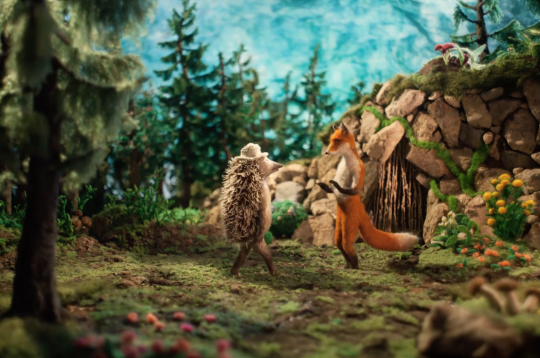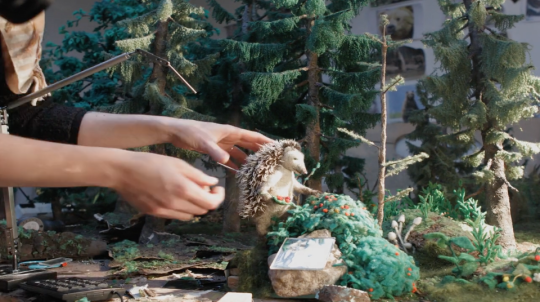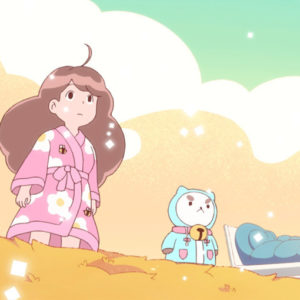Montreal-based director Eva Cvijanović flipped the usual story. Adults encouraged her to become an artist; she poo-pooed the notion for years. Good thing she came around, as her films are magic: innocent with edge; light-heartedly nostalgic; Eva crafts well-worn worlds that keep humming along, unperturbed, long past the credits. Born in Sarajevo, her adaptation of one of the former Yugoslavia’s most beloved tales, “Hedgehog’s Home” by Branko Ćopić, dazzled Berlin Film Festival 2017 goers and scooped up 15 awards worldwide. Check out “Seasick” above, then read on for Eva’s take on new techniques, today’s TV, and giving your seat to elderly people on public transit.

What was your inspiration for “Seasick”?
The Canadian winter. It started as doodles on a train ride. Trains are my favorite mode of transportation. There’s something about that tracking view of the world that stimulates my brain. It was November, winter was coming, and I doodled this fat little creature frolicking around on the shore.
Canada has really good funding for the arts, especially compared to the rest of the world. When I scanned the doodles I realized that together, they read like a storyboard. Half the work was done so I thought, “Why not apply for a grant?” I got one – the NFB helped me with post-production services, which are quite expensive. That’s usually how I work: I put myself in a situation where I have to make the film. Once you get grant money, you have to deliver!
What did you want to be when you were growing up?
I wanted to be a doctor. I was sick a lot and loved playing doctor to my toys. I always enjoyed drawing. Grown-ups around me would be like, “Oh, you should be an artist!” But I never really liked that idea. So it’s funny that I did end up drawing for a living.
Why didn’t you like the idea of being an artist?
I think I felt like it would be a lot of pressure, or too stressful. And it is pressure, it is stressful! It’s not a straightforward job. But it has very satisfying and magical moments. They make up for the difficulty. I still don’t really consider myself an artist. I just like to make movies.
When did filmmaking become your goal?
My dad was involved in the film industry in Sarajevo when we were lived there. He was a film critic. Right before the war he actually started his own production company. So I was always around that world – I did foley for a film when I was like 5. But it was in Montreal during cegep, the 2 year period between high school and university, that I began really playing with animation. That was when the idea of making films, telling stories that way, really caught my interest.

Where’d you study animation?
Concordia University. It’s an interesting program because as a BFA, it’s really more oriented toward the art world. You take history courses on film and art, get a nice background. It’s not just a technical program; it situates you in the world.
Crucial context! After graduating did you go right to work at the NFB?
Not quite. I did a mix of contract work and cafe jobs. I interned on a film that the NFB produced called Higglety Pigglety Pop, based on a story by Maurice Sendak (Where the Wild Things Are). I worked on that for quite a while, alongside other freelance things – I got a tiny grant to make a film of my own. The first big thing I did with the NFB was called Hothouse. It’s a mentorship program, sort of their incubator. I graduated in 2008 and got into Hothouse in 2011. Then I was able to focus just on animation.
What does the Hothouse program involve?
They pick 6 animators and give them each 3 months to make a 1 minute film start to finish. I made “The Kiss”. Of the 6, I was the only one who worked onsite at the NFB. It made such a difference to be in the building, get to know people personally. You know, have lunch with Oscar winners?! It was really wonderful. Pretty intense, but then it is a crash course in how the NFB makes films. I stuck around to help on other people’s films after. Then the editor on my Hothouse film, Jelena Popovic, became a producer. She’s Bosnian like me; we had similar upbringings. She ended up producing “Hedgehog’s Home”.
How did the idea to adapt Hedgehog’s Home form between you guys?
Every child in former Yugoslavia reads Branko Ćopić’s poem when they’re little. It’s taught in the 1st grade. Almost jokingly, I was like, “Hey, what if we did this?” Over time, I ended up writing a script. I sent it to her and she really liked it, so we bounced back and forth on it and then… it happened.
What was it like to adapt a story that was both personal to your own childhood, and so culturally specific to Bosnia and Herzegovina?
It was very interesting for me. It’s a culture that I grew up in, that I think I understand quite well, yet I am also somewhat distanced from it because I haven’t lived in that region for over 20 years. It was good diving into the complexities of the story, which was written after World War II and has major political undertones. A lot of thinking about, “What from this story do I want to focus on?” I’ve always loved stories that have multiple layers. And when you’re a kid, it’s okay to read just one – you needn’t understand everything about the story to enjoy it. So it was all a balance: what to keep; what to omit; how to adapt the story in a way that people who grew up with it wouldn’t hate me for destroying their childhood book. It was also written in a country that doesn’t exist anymore, and it was partially produced by Croatia – so there was a lot of finessing that had to be done on many levels. It was really fun.
How did the experience of making “Hedgehog’s Home” differ from that of your other films?
The NFB provided me the opportunity to be a director. On previous films, I would direct – and do everything else. Here, it’s structured so the director can take time to think about her approach more than anything else, and you have a team to help you bring that vision to life. That was an amazing experience. I’m very, very grateful to the NFB and Bonobo Studio. If I had tried to make this on my own it would have been a very different film. This was the first time that I was like, “Okay, I’m a director. This is what I’m doing.”
Do you have go-to techniques?
I’m most experienced in 2d, but I did some stop motion in school, like my graduation film “Play”. I like navigating different techniques, trying to find the technique that best serves the story I want to tell. There’s always a challenge to new technology too. It keeps things fresh and forces you to problem solve and grow creatively. It’s more difficult at first, of course, but ultimately you get excited about the possibilities. I’m considering doing my next film in Unity.
How did you decide to do “Hedgehog’s Home” in stop motion?
The book has these beautiful illustrations. I grew up with them. I could not imagine doing anything more beautiful in 2d. If I just tried to copy it, it would be lame; if I tried to do something different, it still wouldn’t be as beautiful. Bringing it into the stop motion world solved that problem for me. I could build into this different dimension.

Check out the Making Of video for “Hedgehog’s Home”!
What is your creative process like?
I think for a long time about projects. The more time the world has to marinate in my head, the better the film. The world of Hedgehog’s Home has been marinating in my head for 30 years, so once I started, it was easy to make decisions I was certain about. I knew exactly what I wanted. I think a lot, write things down, then force myself to put a grant proposal together. If I get a grant, I’ll put a team together – after working with a crew on Hedgehog’s, I don’t want to go back to making everything by myself. I enjoy the collaborative aspect, everyone contributing – and working with people who are better at what they do than I am. Then, we’d probably make an animatic and work with that and a script to get the skeleton straight. I mostly do narrative films. My head works within narrative structure, even if my stories aren’t the most linear or straightforward. I also work with a lot a lot of reference materials.
Then, depending on the technique we choose, everything will be different. With “Hedgehog’s”, it was getting our hands dirty, actually building the world, that informed how things would look. I don’t think designing everything and then making the film works for me; I’d rather do both simultaneously. The final look of that film probably wasn’t locked until the first day of the shoot.
Wow. What inspired your Naked Island film, “Survival of the Fittest”?
Jelena, the producer on “Hedgehog’s Home”, approached me. Naked Island was her idea. She wanted to make short political films with a punch. She asked me if there was anything that pissed me off. For me, it’s always easier to address – and connect with – small, direct things than big ideas. So I decided to focus on an everyday instance. I was taught to always let older people sit on public transit, and in Montreal… it’s not such a thing. It’s really difficult for me to see pregnant women or elderly people standing while very healthy, active people are sitting down. I know it’s kind of a small thing, but I think it relates to a bigger issue: living collectively, not just individually. That’s where the title comes in, because ‘fittest’ doesn’t necessarily mean an individual. I think the reason for the humanity’s survival is our collective nature.
Do you have an aspiration or goal, in film or another medium, that you feel you’re working toward?
Yes – I’d really love to explore serial storytelling. A lot of the content I consume these days is serial. I think the game has been brought to another level in the past couple years. The short film can be quite limiting – but I do like the limits of a single episode. One small segment, but combined with others of its kind, makes up a larger story. That’s something I’d love, love, love to do someday.
What are some of the shows that inspire you?
I really love Twin Peaks. I’m sure everybody says that. For me, it’s that unorthodox way of tying a story together in a serial format. I also love Atlanta; it blows my mind. Each episode is its own little movie and yet there’s the bigger narrative running throughout. So those are two touchstones.
You’re currently working to get a film funded – can you say what about?
Yeah! Very much in development, but it would be a science fiction film. It’s set in a speculative future not too far from today, during an interplanetary journey.
Cool! Does it star adults or kids?
I think this one’s a bit more for grown ups.
Will that be a bit of a departure for you?
It’s funny, because besides “Hedgehog’s”, for a lot of my films, I never thought I was making a kid’s film – but they did well in children’s festivals! It might have something of interest to children’s programmers, but this idea is an adult-oriented world. I tend to think about audience in terms of what I would like to see. Not to say it isn’t important! I just don’t tell myself, “Okay, this is gonna be a children’s film,” you know? Even with “Hedgehog’s”, which is obviously based on a children’s book – I always felt the book was for both kids and grown-ups. It was fun to play that game of, what information is here for the adults; what’s here for the kids? I don’t like to underestimate the kids, nor the ability of adults to enjoy playful, childlike things. I think our brains are very connected – there’s a bit of a child in our grown up selves. And kids understand the world in very profound ways… I never want to undermine their intelligence. ❀
Follow Eva on Vimeo and Twitter,
Thank you for the interview Eva! I’m already a fan of your future TV show, whatever it shall be. All the best getting your next short made!
– Cooper ❀



